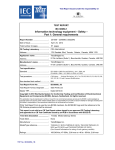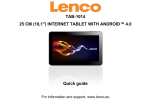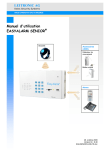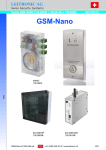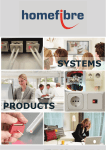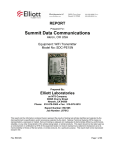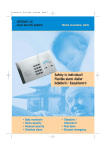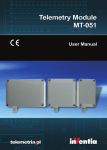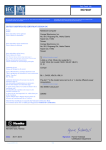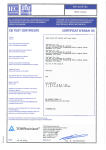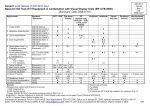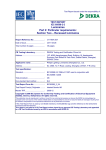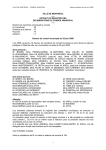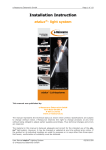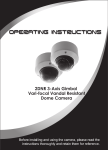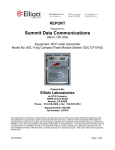Download CETECOM ICT Services GmbH Accredited testing
Transcript
CETECOM ICT Services GmbH Untertürkheimerstr. 6-10 D-66117 Saarbrücken Phone : +49 (0)681 598 - 0 / Fax: - 9075 Laboratory for Product Safety Page 1 of 52 Phone : +49 (0)681 598 - 8513 Accredited testing laboratory TEST REPORT IEC 60950-1: 2005 (2nd Edition)/A1:2009 and EN 60950-1: 2006/A11:2009/A1:2010/A12: 2011 Information technology equipment – Safety – Part 1: General requirements Report Reference No. .................... : 1-5812/13-01-02 Test Item ......................................... : EA-GSM-Interface (Nano) Test result ....................................... : The test item passed! Remark: This test report is electronically signed and valid without handwriting signature. For verification of the electronical signatures, the public keys can be requested at the testing laboratory. Tested by (printed name and signature) .......... : Sébastien Scheidler Approved by (printed name and signature) .......... : Jürgen Sanetra Date of issue ................................... : 31.01.2013 Testing Laboratory ........................ : CETECOM ICT Services GmbH Address ............................................ : Untertürkheimerstr. 6-10 D-66117 Saarbrücken Applicant’s name ........................... : Leitronic AG Address ............................................ : Engeloostr. 16 5621 Zufikon Switzerland Manufacturer’s name ..................... : Same as applicant cn=Sebastien Scheidler, o=CETECOM ICT Services GmbH, ou=SHE-100805, email=sebastien.scheidler@cet ecom.com, c=DE 2013.01.31 16:09:46 +01'00' cn=Juergen Sanetra, o=CETECOM ICT Services GmbH, ou=SAT-100806, [email protected] om, c=DE 2013.01.31 15:27:33 +01'00' Address ............................................ : Test specification: Standard........................................... : IEC 60950-1:2005 (2. Edition)/A1:2009 and EN 60950-1:2006/A11:2009/A1:2010/A12:2011 Test procedure ................................. : CE, AA WC 34 Non-standard test method…………..: N/A Report No. 1-5812/13-01-03 Page 2 of 52 Test Report Form No. .................... : Modified IEC60950_1B Test Report Form(s) Originator ........ : SGS Fimko Ltd, modified by CETECOM Master TRF ...................................... : Dated 2010-04 Copyright © 2010 Worldwide System for Conformity Testing and Certification of Electrotechnical Equipment and Components (IECEE), Geneva, Switzerland. All rights reserved. This publication may be reproduced in whole or in part for non-commercial purposes as long as the IECEE is acknowledged as copyright owner and source of the material. IECEE takes no responsibility for and will not assume liability for damages resulting from the reader's interpretation of the reproduced material due to its placement and context. If this Test Report Form is used by non-IECEE members, the IECEE/IEC logo and the reference to the CB Scheme procedure shall be removed. This report is not valid as a CB Test Report unless signed by an approved CB Testing Laboratory and appended to a CB Test Certificate issued by an NCB in accordance with IECEE 02. Notes and Disclaimer The test results of this test report relate exclusively to the test item specified in this test report. CETECOM ICT Services GmbH does not assume responsibility for any conclusions and generalizations drawn from the test results with regard to other specimens or samples of the type of the equipment represented by the test item. The test report may only be reproduced or published in full. Reproduction or publication of extracts from the report requires the prior written approval of CETECOM ICT Services GmbH. The testing service provided by CETECOM ICT Services GmbH has been rendered under the current "General Terms and Conditions for CETECOM ICT Services GmbH". CETECOM ICT Services GmbH will not be liable for any loss or damage resulting from false, inaccurate, inappropriate or incomplete product information provided by the customer. Under no circumstances does the CETECOM ICT Services GmbH test report include any endorsement or warranty regarding the functionality, quality or performance of any other product or service provided. Under no circumstances does the CETECOM ICT Services GmbH test report include or imply any product or service warranties from CETECOM ICT Services GmbH, including, without limitation, any implied warranties of merchantability, fitness for purpose, or non-infringement, all of which are expressly disclaimed by CETECOM ICT Services GmbH. All rights and remedies regarding vendor’s products and services for which CETECOM ICT Services GmbH has prepared this test report shall be provided by the party offering such products or services and not by CETECOM ICT Services GmbH. In no case this test report can be considered as a Letter of Approval. Accredited Testing Laboratory The testing laboratory (area of testing) is accredited according to DIN EN ISO/IEC 17025 (2005) by the Deutsche Akkreditierungsstelle GmbH (DAkkS). The accreditation is valid for the scope of testing procedures as stated in the accreditation certificate with the registration number: D-PL-12076-01-01 Accreditation Certificate Note: The current certificate including annex is published on our website (link see below) or may be received from CETECOM ICT Services on request http://www.cetecom.com/fileadmin/de/CETECOM_D_Saarbruecken/accreditations_Jan_2010/DAKKS_Akkre di_Urk_EN17025-En_incl_Annex.pdf Test item description ..................... : GSM Gateway Trade Mark ....................................... : Leitronic Manufacturer .................................... : Same as applicant Model/Type reference ...................... : EA-GSM-Interface (Nano) Ratings ............................................. : 230V, 50Hz, 63mA Report No. 1-5812/13-01-03 Page 3 of 52 Additional information: The EUT was tested under the following conditions: - Temperature in the range of 20 – 30°C unless otherwise specified - A relevant humidity in the range of 35-75% r.H. - An air pressure in range of 86kPa to 106kPa Summary of testing: The sample(s) tested complies with the requirements of IEC 60950-1:2005 (2. Edition)/A1:2009 and EN 60950-1: 2006/A11:2009/A1:2010/A12:2011. Compliance with National Differences, Special National Conditions, Annex ZB, and A – Deviations, Annex ZC are recorded at the end of this report. Summary of compliance with National Differences: The following group and/or national deviations were considered: AT, BE, CH, CS, CZ, DE, DK, ES, FI, FR, GB, GR, HU, IE, IT, NL, NO, PL, PT, RU, SE, SI, SK, TR, UA Abbreviations used in this test report: NC: Normal Condition DC: Direct Current OP: Operational insulation PS: Power Supply BI: Basic Insulation SEC: Secondary circuit DI: Double insulation PRI: AC: Alternating Current PCB: Printed circuit board PE: Protective earth SC: Primary circuit Short Circuit GND: Signal Ground BAT: Battery OC: PoE: Power over Ethernet Open Circuit PABX: Private Automatic Branch eXchange Country abbreviations used in this test report: AE United Arab Emirates AR Argentina AT Austria AU Australia BE Belgium BR Brazil CA Canada CH Switzerland CN China RS Serbia CZ The Czech Republic DE Germany DK Denmark ES Spain EU European Union FI Finland FR France GB United Kingdom GR Greece HU Hungary IE Ireland IL Israel IT Italy IN India JP Japan KR Rep. of Korea MY Malaysia NL Netherlands NO Norway NZ New Zealand PL Poland PT Portugal RU Russian federation SE Sweden SG Singapore SK Slovakia SI Slovenia TR Turkey UA Ukraine US United States of America ZA South Africa Report No. 1-5812/13-01-03 Copies of marking plates: Page 4 of 52 Report No. 1-5812/13-01-03 Page 5 of 52 Test item particulars ..................................... : Equipment mobility ........................................: Stationary Connection to the mains ...............................: pluggable equipment type A non detachable power supply cord Operating condition .......................................: continuous Over voltage category (OVC) .......................: II Mains supply tolerance (%)...........................: ± 10% Tested for IT power systems ........................: Yes (Norway only) IT testing, phase-phase voltage (V) .............: 230V Class of equipment ......................................: I Pollution degree (PD) ...................................: 2 Rated atmospheric humidity .........................: 10 to 85% (Non Condensing) Rated temperature range ..............................: 5°C to + 35°C Access location .............................................: operator accessible Enclosure material ........................................: Plastic HB PCB material .................................................: V-0 IP protection class ........................................: 67 Mass of equipment (kg) ................................: 1.7 Altitude during operation (m) ........................: ≤ 2000 Safety classification of interfaces ..................: PS mains: All other: Insulation classification .................................: PS mains – SEC: Hazardous Earthed SELV Basic Possible test case verdicts ........................: - test case does not apply to the test object .: N/A - test object does meet the requirement .......: P (Pass) - test object does not meet the requirement .: F (Fail) Testing .........................................................: Date of receipt of test item ............................: 07.01.2013 Date(s) of performance of tests ....................: 07.01. – 29.01.2013 General remarks: The test results presented in this report relate only to the object tested. This report shall not be reproduced, except in full, without the written approval of the Issuing testing laboratory. "(see Enclosure #)" refers to additional information appended to the report. "(see appended table)" refers to a table appended to the report. Throughout this report a comma / point is used as the decimal separator. General product information: The EUT is a GSM Gateway The following Attachments are integral part of this test report: - Annex 1: Photo documentation Report No. 1-5812/13-01-03 Page 6 of 52 IEC/EN 60950-1 Clause Requirement + Test Result - Remark 1 GENERAL P 1.5 Components P 1.5.1 General See appended table 1.5.1 Verdict P Comply with IEC 60950 or relevant component standard P 1.5.2 Evaluation and testing of components P 1.5.3 Thermal controls 1.5.4 Transformers 1.5.5 Interconnecting cables No interconnecting cables N/A 1.5.6 Capacitors bridging insulation No such parts N/A 1.5.7 Resistors bridging insulation No such parts N/A 1.5.7.1 Resistors bridging functional, basic or supplementary insulation N/A 1.5.7.2 Resistors bridging double or reinforced insulation between AC mains and other circuits N/A 1.5.7.3 Resistors bridging double or reinforced insulation between AC mains and antenna or coaxial cable N/A 1.5.8 Components in equipment for IT power systems P 1.5.9 Surge suppressors 1.5.9.1 General N/A 1.5.9.2 Protection of VDRs N/A 1.5.9.3 Bridging of functional insulation by a VDR N/A 1.5.9.4 Bridging of basic insulation by a VDR N/A 1.5.9.5 Bridging of supplementary, double or reinforced insulation by a VDR N/A 1.6 Power interface P 1.6.1 AC power distribution systems P 1.6.2 Input current See appended table 1.6.2 1.6.3 Voltage limit of hand-held equipment Not hand held 1.6.4 Neutral conductor P 1.7 Marking and instructions P 1.7.1 Power rating and identification markings No thermal controls N/A N/A No surge suppressors See copy of marking plate N/A P N/A P (ISO 3864, No. 5036) N/A (ISO 7000-0434) N/A Report No. 1-5812/13-01-03 Page 7 of 52 IEC/EN 60950-1 Clause Requirement + Test Result - Remark (direct current, IEC 60417, 417-IEC-5031-a) Verdict N/A (single phase, IEC 60417, 417-IEC-5032-a) (230V ): Power indication N/A 3 N/A (three phase IEC 60417, 417-IEC-5032-a) 3N (three phase with neutral, IEC 60417, 417IEC-5032-a) N/A (Class II equipment, IEC 60417, 417-IEC-5172a): On the bottom N/A (protection, IEC 60417, 417-IEC-5016-a) N/A (connector, holder or core, IEC 60417, 417-IEC5020-a) N/A (protective earth, IEC 60417, 417-IEC-5019-a) N/A (insulation transformers, IEC 60417, 417-IEC5221) N/A N/A Short circuit protected transformer IEC 60417, 417-IEC-5220-a N/A Indoor use only, IEC 60417, 417-IEC-5957 N/A Hot surface. IEC 60417-1-5041 1.7.1.1 1.7.1.2 Power rating marking P Multiple mains supply connections ..................... : N/A Rated voltage(s) or voltage range(s) (V) ........... : P Symbol for nature of supply, for DC only ............ : N/A Rated frequency or rated frequency range (Hz) : P Rated current (mA or A) ..................................... : P Identification markings P Manufacturer’s name or trade-mark or identification mark ................................................................... : P Model identification or type reference ................ : P Symbol for Class II equipment only ................... : N/A P Other markings and symbols : CE, 1.7.2 Safety instructions and marking In user manual P 1.7.2.1 General P 1.7.2.2 Disconnect devices P 1.7.2.3 Overcurrent protective device N/A 1.7.2.4 IT power distribution systems P Report No. 1-5812/13-01-03 Page 8 of 52 IEC/EN 60950-1 Clause Requirement + Test Result - Remark 1.7.2.5 Operator access with a tool No operator access with a tool N/A 1.7.2.6 Ozone No ozone N/A 1.7.3 Short duty cycles Continuous operation N/A 1.7.4 Supply voltage adjustment ................................. : No supply voltage adjustment N/A Methods and means of adjustment; reference to installation instructions ....................................... : Verdict N/A 1.7.5 Power outlets on the equipment ........................ : No power outlets 1.7.6 Fuse identification (marking, special fusing characteristics, cross-reference) ........................ : 1.7.7 Wiring terminals No wiring terminals N/A 1.7.7.1 Protective earthing and bonding terminals ........ : No earthing and bonding N/A 1.7.7.2 Terminals for AC mains supply conductors No AC mains N/A 1.7.7.3 Terminals for DC mains supply conductors No DC mains N/A 1.7.8 Controls and indicators Not safety relevant N/A 1.7.8.1 Identification, location and marking .................... : N/A 1.7.8.2 Colours .............................................................. : N/A 1.7.8.3 Symbols according to IEC 60417........................ : N/A for "ON" (60417-1-IEC-5007) N/A for "OFF" (60417-1-IEC-5008) N/A P N/A push-push (60417-1-IEC-5010) stand-by N/A N/A (60417-1-IEC-5009) 1.7.8.4 Markings using figures ...................................... : N/A 1.7.9 Isolation of multiple power sources .................... : One power source N/A 1.7.10 Thermostats and other regulating devices ......... : Not such devices N/A 1.7.11 Durability Name plate P 1.7.12 Removable parts Not on removable parts P 1.7.13 Replaceable batteries ........................................ : Replacement by incorrect type not possible P Language(s) ....................................................... : 1.7.14 Equipment for restricted access locations .......... : EUT is for user access area N/A 2 PROTECTION FROM HAZARDS 2.1 Protection from electric shock and energy hazards 2.1.1 Protection in operator access areas P 2.1.1.1 Access to energized parts P Test by inspection .............................................. : P P SELV circuits only P Report No. 1-5812/13-01-03 Page 9 of 52 IEC/EN 60950-1 Clause Requirement + Test Result - Remark Verdict Test with test finger (Figure 2A) ......................... : P Test with test pin (Figure 2B) ............................. : P Test with test probe (Figure 2C) ........................ : No TNV circuits N/A 2.1.1.2 Battery compartments No TNV circuits N/A 2.1.1.3 Access to ELV wiring No ELV circuits N/A Working voltage (Vpeak or Vrms); minimum distance through insulation (mm) 2.1.1.4 Access to hazardous voltage circuit wiring No access to hazardous voltage 2.1.1.5 Energy hazards .................................................. : No energy hazards 2.1.1.6 Manual controls 2.1.1.7 Discharge of capacitors in equipment N/A N/A No capacitor in primary circuit N/A Measured voltage (V); time-constant (s)............. : 2.1.1.8 P Energy hazards – DC mains supply N/A a) Capacitor connected to the DC mains supply : N/A b) Internal battery connected to the DC mains supply ............................................................................ : N/A 2.1.1.9 Audio amplifiers .................................................. : No audio amplifier N/A 2.1.2 Protection in service access areas N/A 2.1.3 Protection in restricted access locations N/A 2.2 SELV circuits P 2.2.1 General requirements P 2.2.2 Voltages under normal conditions (V) ................... : Within SELV limits P 2.2.3 Voltages under fault conditions (V) ....................... : Within SELV limits P 2.2.4 Connection of SELV circuits to other circuits ........ : SELV to SELV P 2.3 TNV circuits No TNV circuits N/A 2.3.1 Limits N/A Type of TNV circuits ............................................... : 2.3.2 Separation from other circuits and from accessible parts N/A 2.3.2.1 General requirements N/A 2.3.2.2 Protection by basic insulation N/A 2.3.2.3 Protection by earthing N/A 2.3.2.4 Protection by other constructions .......................... : N/A 2.3.3 Separation from hazardous voltages N/A Report No. 1-5812/13-01-03 Page 10 of 52 IEC/EN 60950-1 Clause Requirement + Test Result - Remark Insulation employed ............................................... : 2.3.4 Verdict Connection of TNV circuits to other circuits N/A Insulation employed ............................................... : 2.3.5 Test for operating voltages generated externally N/A 2.4 Limited current circuits 2.4.1 General requirements N/A 2.4.2 Limit values N/A No limited current circuits N/A Frequency (Hz) ...................................................... : Measured current (mA) .......................................... : Measured voltage (V) ............................................. : Measured circuit capacitance (nF or µF) ............... : 2.4.3 Connection of limited current circuits to other circuits 2.5 Limited power sources N/A See appended table 2.5 P a) Inherently limited output P b) Impedance limited output N/A c) Regulating network limited output under normal operating and single fault condition N/A d) Overcurrent protective device limited output N/A Max. output voltage (V), max. output current (A), max. apparent power (VA) .............................................. : Current rating of overcurrent protective device (A) Use of integrated circuit (IC) current limiters N/A 2.6 Provisions for earthing and bonding P 2.6.1 Protective earthing P 2.6.2 Functional earthing N/A 2.6.3 Protective earthing and protective bonding conductors P 2.6.3.1 General P 2.6.3.2 Size of protective earthing conductors P 2 2.6.3.3 Rated current (A), cross-sectional area (mm ), AWG ............................................................................... : <1A, 0.75mm² Size of protective bonding conductors No bonding connectors 2 Rated current (A), cross-sectional area (mm ), AWG ............................................................................... : N/A Report No. 1-5812/13-01-03 Page 11 of 52 IEC/EN 60950-1 Clause Requirement + Test Result - Remark Verdict 2.6.3.4 Resistance of earthing conductors and their terminations; resistance (), voltage drop (V), test current (A), duration (min) ...................................... : N/A 2.6.3.5 Color of insulation .................................................. : P 2.6.4 Terminals N/A 2.6.4.1 General N/A 2.6.4.2 Protective earthing and bonding terminals N/A Rated current (A), type, nominal thread diameter (mm) ....................................................................... : 2.6.4.3 Separation of the protective earthing conductor from protective bonding conductors N/A 2.6.5 Integrity of protective earthing P 2.6.5.1 Interconnection of equipment N/A 2.6.5.2 Components in protective earthing conductors and protective bonding conductors N/A 2.6.5.3 Disconnection of protective earth 2.6.5.4 Parts that can be removed by an operator N/A 2.6.5.5 Parts removed during servicing N/A 2.6.5.6 Corrosion resistance N/A 2.6.5.7 Screws for protective bonding N/A 2.6.5.8 Reliance on telecommunication network or cable distribution system N/A 2.7 Overcurrent and earth fault protection in primary circuits P 2.7.1 Basic requirements P Instructions when protection relies on building installation P 2.7.2 Faults not simulated in 5.3.7 P 2.7.3 Short-circuit backup protection P 2.7.4 Number and location of protective devices ........... : 2.7.5 Protection by several devices N/A 2.7.6 Warning to service personnel ................................ : N/A 2.8 Safety interlocks 2.8.1 General principles N/A 2.8.2 Protection requirements N/A 2.8.3 Inadvertent reactivation N/A 2.8.4 Fail-safe operation N/A P 1 in L line No safety interlocks P N/A Report No. 1-5812/13-01-03 Page 12 of 52 IEC/EN 60950-1 Clause Requirement + Test 2.8.5 Moving parts N/A 2.8.6 Overriding N/A 2.8.7 Switches and relays N/A 2.8.7.1 Contact gaps (mm) ................................................ : N/A 2.8.7.2 Overload test N/A 2.8.7.3 Endurance test N/A 2.8.7.4 Electric strength test N/A 2.8.8 Mechanical actuators N/A 2.9 Electrical insulation P 2.9.1 Properties of insulating materials 2.9.2 Humidity conditioning 2.9.3 Grade of insulation 2.9.4 Separation from hazardous voltages Method(s) used ..................................................... : Result - Remark Neither natural rubber, materials containing asbestos no hygroscopic material are used as insulation Verdict P N/A Basic insulation P P e) 2.10 Clearances, creepage distances and distances through insulation P 2.10.1 General P 2.10.1.1 Frequency ............................................................. : 50Hz P 2.10.1.2 Pollution degrees .................................................. : 2 P 2.10.1.3 Reduced values for functional insulation For functional insulation creepage distances and clearances smaller than those specified in clause 2.10 are permitted subject to the requirements of clause 5.3.4 c) P See appended table 5.3 2.10.1.4 Intervening unconnected conductive parts N/A 2.10.1.5 Insulation with varying dimensions N/A 2.10.1.6 Special separation requirements N/A 2.10.1.7 Insulation in circuits generating starting pulses N/A 2.10.2 Determination of working voltage P 2.10.2.1 General P 2.10.2.2 RMS working voltage 242V P Report No. 1-5812/13-01-03 Page 13 of 52 IEC/EN 60950-1 Clause Requirement + Test Result - Remark 2.10.2.3 Peak working voltage 342V 2.10.3 Clearances P 2.10.3.1 General P 2.10.3.2 Mains transient voltages P a) AC mains supply ............................................... : 2500V Verdict P P b) Earthed DC mains supplies .............................. : N/A c) Unearthed DC mains supplies .......................... : N/A d) Battery operation ............................................... : N/A 2.10.3.3 Clearances in primary circuits P 2.10.3.4 Clearances in secondary circuits N/A 2.10.3.5 Clearances in circuits having starting pulses N/A 2.10.3.6 Transients from AC mains supply ......................... : 2.10.3.7 Transients from DC mains supply ......................... : N/A 2.10.3.8 Transients from telecommunication networks and cable distribution systems ..................................... : N/A 2.10.3.9 Measurement of transient voltage levels N/A a) Transients from a mains supply N/A For an AC mains supply ........................................ : N/A For a DC mains supply ......................................... : N/A b) Transients from a telecommunication network .. : N/A 2500V P 2.10.4 Creepage distances P 2.10.4.1 General P 2.10.4.2 Material group and comparative tracking index P CTI tests ................................................................. : IIIa/IIIb 2.10.4.3 Minimum creepage distances 2.10.5 Solid insulation N/A 2.10.5.1 General N/A 2.10.5.2 Distances through insulation N/A 2.10.5.3 Insulating compound as solid insulation N/A 2.10.5.4 Semiconductor devices N/A 2.10.5.5 Cemented joints N/A 2.10.5.6 Thin sheet material – General N/A 2.10.5.7 Separable thin sheet material N/A Number of layers (pcs) ........................................... : P 2.10.5.8 Non-separable thin sheet material N/A 2.10.5.9 Thin sheet material – standard test procedure N/A Report No. 1-5812/13-01-03 Page 14 of 52 IEC/EN 60950-1 Clause Requirement + Test Electric strength test 2.10.5.10 Thin sheet material – alternative test procedure Result - Remark Verdict N/A Electric strength test 2.10.5.11 Insulation in wound components N/A 2.10.5.12 Wire in wound components N/A Working voltage .................................................... : N/A a) Basic insulation not under stress ...................... : N/A b) Basic, supplementary, reinforced insulation ..... : N/A c) Compliance with Annex U ................................. : N/A Two wires in contact inside wound component; angle between 45 and 90 ............................................. : N/A 2.10.5.13 Wire with solvent-based enamel in wound components Electric strength test Routine test 2.10.5.14 Additional insulation in wound components N/A N/A N/A Working voltage .................................................... : N/A - Basic insulation not under stress ........................ : N/A - Supplementary, reinforced insulation ................. : N/A 2.10.6 Construction of printed boards N/A 2.10.6.1 Uncoated printed boards N/A 2.10.6.2 Coated printed boards N/A 2.10.6.3 Insulation between conductors on the same inner surface of a printed board N/A 2.10.6.4 Insulation between conductors on different layers of a printed board N/A Distance through insulation N/A Number of insulation layers (pcs) .......................... : N/A 2.10.7 Component external terminations N/A 2.10.8 Tests on coated printed boards and coated components N/A 2.10.8.1 Sample preparation and preliminary inspection N/A 2.10.8.2 Thermal conditioning N/A 2.10.8.3 Electric strength test N/A 2.10.8.4 Abrasion resistance test N/A 2.10.9 Thermal cycling N/A 2.10.10 Test for Pollution Degree 1 environment and insulating compound N/A Report No. 1-5812/13-01-03 Page 15 of 52 IEC/EN 60950-1 Clause Requirement + Test Result - Remark 2.10.11 Tests for semiconductor devices and cemented joints N/A 2.10.12 Enclosed and sealed parts N/A 3 WIRING, CONNECTIONS AND SUPPLY 3.1 General P 3.1.1 Current rating and overcurrent protection P 3.1.2 Protection against mechanical damage P 3.1.3 Securing of internal wiring P 3.1.4 Insulation of conductors P 3.1.5 Beads and ceramic insulators N/A 3.1.6 Screws for electrical contact pressure N/A 3.1.7 Insulating materials in electrical connections N/A 3.1.8 Self-tapping and spaced thread screws N/A 3.1.9 Termination of conductors N/A 10 N pull test N/A 3.1.10 Sleeving on wiring N/A 3.2 Connection to a mains supply P 3.2.1 Means of connection P 3.2.1.1 Connection to an AC mains supply P 3.2.1.2 Connection to a DC mains supply N/A 3.2.2 Multiple supply connections No multiple supply connection N/A 3.2.3 Permanently connected equipment Not permanently connected N/A PCB wiring only Verdict P Number of conductors, diameter of cable and conduits (mm) ....................................................... : 3.2.4 Appliance inlets No appliance inlet N/A 3.2.5 Power supply cords No power supply cord provided N/A 3.2.5.1 AC power supply cords Type ...................................................................... : Rated current (A), cross-sectional area (mm2), AWG ............................................................................... : 3.2.5.2 DC power supply cords 3.2.6 Cord anchorages and strain relief Mass of equipment (kg), pull (N) .......................... : 3.2.7 N/A N/A P 1.7, 60N Longitudinal displacement (mm) ........................... : Protection against mechanical damage P Report No. 1-5812/13-01-03 Page 16 of 52 IEC/EN 60950-1 Clause Requirement + Test 3.2.8 Cord guards Result - Remark Verdict N/A Diameter or minor dimension D (mm); test mass (g) ............................................................................... : Radius of curvature of cord (mm) .......................... : 3.2.9 Supply wiring space N/A 3.3 Wiring terminals for connection of external conductors 3.3.1 Wiring terminals N/A 3.3.2 Connection of non-detachable power supply cords N/A 3.3.3 Screw terminals N/A 3.3.4 Conductor sizes to be connected N/A No terminals Rated current (A), cord/cable type, cross-sectional area (mm2) ............................................................. : 3.3.5 N/A Wiring terminal sizes N/A Rated current (A), type, nominal thread diameter (mm) ...................................................................... : 3.3.6 Wiring terminal design N/A 3.3.7 Grouping of wiring terminals N/A 3.3.8 Stranded wire N/A 3.4 Disconnection from the mains supply P 3.4.1 General requirement P 3.4.2 Disconnect devices P 3.4.3 Permanently connected equipment N/A 3.4.4 Parts which remain energized N/A 3.4.5 Switches in flexible cords 3.4.6 Number of poles - single-phase and DC equipment 3.4.7 Number of poles - three-phase equipment 3.4.8 Switches as disconnect devices 3.4.9 Plugs as disconnect devices 3.4.10 Interconnected equipment N/A 3.4.11 Multiple power sources N/A 3.5 Interconnection of equipment P 3.5.1 General requirements P 3.5.2 Types of interconnection circuits ........................... : P 2 P N/A No switches N/A P SELV P Report No. 1-5812/13-01-03 Page 17 of 52 IEC/EN 60950-1 Clause Requirement + Test Result - Remark Verdict 3.5.3 ELV circuits as interconnection circuits No ELV circuits N/A 3.5.4 Data ports for additional equipment No data ports N/A 4 PHYSICAL REQUIREMENTS 4.1 Stability N/A Angle of 10 N/A Test force (N) ........................................................ : N/A P 4.2 Mechanical strength P 4.2.1 General P Rack-mounted equipment. Not rack mounted 4.2.2 Steady force test, 10 N Internal components 4.2.3 Steady force test, 30 N No cover N/A 4.2.4 Steady force test, 250 N Enclosure P 4.2.5 Impact test P Fall test P Swing test 4.2.6 Drop test; height (mm) .......................................... : 4.2.7 Stress relief test 4.2.8 Cathode ray tubes N/A P N/A 750 P N/A No cathode ray tubes Picture tube separately certified ............................ : N/A N/A 4.2.9 High pressure lamps No high pressure lamps 4.2.10 Wall or ceiling mounted equipment; force (N) ....... : 50N 4.2.11 Rotating solid media No rotating solid media Test to cover on the door…………………………….: N/A P N/A N/A P 4.3 Design and construction 4.3.1 Edges and corners No sharp edges and corners 4.3.2 Handles and manual controls; force (N) ................ : No handles and manual controls N/A 4.3.3 Adjustable controls No adjustable controls N/A 4.3.4 Securing of parts All parts secured P 4.3.5 Connection by plugs and sockets IEC 60083 and IEC 60320 connectors not in SELVcircuits P 4.3.6 Direct plug-in equipment No direct plug-in equipment N/A P Report No. 1-5812/13-01-03 Page 18 of 52 IEC/EN 60950-1 Clause Requirement + Test Result - Remark Compliance with the relevant mains plug standard ............................................................................... : Verdict N/A 4.3.7 Heating elements in earthed equipment No heating elements 4.3.8 Batteries See appended table 4.3.8 - Overcharging of a rechargeable battery N/A P P - Unintentional charging of a non-rechargeable battery N/A - Reverse charging of a rechargeable battery N/A - Excessive discharging rate for any battery P 4.3.9 Oil and grease No exposure to oil or grease N/A 4.3.10 Dust, powders, liquids and gases No exposure to dust, powders, liquids and gases N/A 4.3.11 Containers for liquids or gases No containers for liquids or gases N/A 4.3.12 Flammable liquids ................................................. : No flammable liquids N/A Quantity of liquid (l) ............................................... : N/A Flash point (C) ..................................................... : N/A 4.3.13 Radiation 4.3.13.1 General N/A 4.3.13.2 Ionizing radiation N/A 4.3.13.3 No radiations N/A Measured radiation (pA/kg) ................................... : Measured high-voltage (kV) .................................. : Measured focus voltage (kV) ................................ : CRT markings ....................................................... : Effect of ultraviolet (UV) radiation on materials N/A Part, property, retention after test, flammability classification .......................................................... : N/A 4.3.13.4 Human exposure to ultraviolet (UV) radiation ....... : N/A 4.3.13.5 Lasers (including laser diodes) and LEDs No laser 4.3.13.5.1 Lasers (including laser diodes) N/A N/A Laser class ............................................................ : 4.3.13.5.2 Light emitting diodes (LEDs) N/A 4.3.13.6 Other types ............................................................ : N/A 4.4 Protection against hazardous moving parts 4.4.1 General N/A 4.4.2 Protection in operator access areas ..................... : N/A No moving parts N/A Report No. 1-5812/13-01-03 Page 19 of 52 IEC/EN 60950-1 Clause Requirement + Test Result - Remark Verdict Household and home/office document/media shredders N/A 4.4.3 Protection in restricted access locations ............... : N/A 4.4.4 Protection in service access areas N/A 4.4.5 Protection against moving fan blades N/A 4.4.5.1 General N/A Not considered to cause pain or injury. a) ............. : N/A Is considered to cause pain, not injury. b) ............. : N/A Considered to cause injury. N/A 4.4.5.2 c) ............. : Protection for users N/A N/A 4.4.5.3 ) .... : Use of symbol or warning (ISO 3864-2 WARNING Hazardous moving parts Keep away from moving fan blades N/A Protection for service persons N/A Use of symbol or warning …………………………: N/A See appended table 4.5 P 4.5 Thermal requirements 4.5.1 General P 4.5.2 Temperature tests P Normal load condition per Annex L ....................... : 7 4.5.3 Temperature limits for materials P 4.5.4 Touch temperature limits P 4.5.5 Resistance to abnormal heat ................................ : 4.6 Openings in enclosures P 4.6.1 Top and side openings P 4.6.2 No hazardous parts Dimensions (mm) .................................................. : No openings Bottoms of fire enclosures No fire enclosure N/A Construction of the bottom, dimensions (mm) ...... : 4.6.3 Doors or covers in fire enclosures No fire enclosure 4.6.4 Openings in transportable equipment No openings 4.6.4.1 Constructional design measures Dimensions (mm) .................................................. : N/A N/A P N/A 4.6.4.2 Evaluation measures for larger openings N/A 4.6.4.3 Use of metalized parts N/A Report No. 1-5812/13-01-03 Page 20 of 52 IEC/EN 60950-1 Clause Requirement + Test Result - Remark 4.6.5 Adhesives for constructional purposes No adhesives for constructional purposes Verdict N/A Conditioning temperature (C), time (weeks) ........ : 4.7 Resistance to fire P 4.7.1 Reducing the risk of ignition and spread of flame P Method 1, selection and application of components wiring and materials N/A Method 2, application of all of simulated fault condition tests See appended table 5.3 P 4.7.2 Conditions for a fire enclosure No fire enclosure 4.7.2.1 Parts requiring a fire enclosure 4.7.2.2 Parts not requiring a fire enclosure Method 2 conducted P 4.7.3 Materials See appended table 1.5.1 P 4.7.3.1 General 4.7.3.2 Materials for fire enclosures 4.7.3.3 Materials for components and other parts outside fire enclosures N/A 4.7.3.4 Materials for components and other parts inside fire enclosures N/A 4.7.3.5 Materials for air filter assemblies No air filter assemblies N/A 4.7.3.6 Materials used in high-voltage components No high-voltage components N/A 5 ELECTRICAL REQUIREMENTS AND SIMULATED ABNORMAL CONDITIONS P 5.1 Touch current and protective conductor current P 5.1.1 General 5.1.2 Configuration of equipment under test (EUT) P 5.1.2.1 Single connection to an AC mains supply P 5.1.2.2 Redundant multiple connections to an AC mains supply N/A 5.1.2.3 Simultaneous multiple connections to an AC mains supply N/A 5.1.3 Test circuit P 5.1.4 Application of measuring instrument P 5.1.5 Test procedure P 5.1.6 Test measurements P Supply voltage (V) ................................................. : N/A N/A P No fire enclosure See appended table 5.1 N/A P Report No. 1-5812/13-01-03 Page 21 of 52 IEC/EN 60950-1 Clause Requirement + Test Result - Remark Verdict Measured touch current (mA) ............................... : Max. allowed touch current (mA) .......................... : Measured protective conductor current (mA) ....... : Max. allowed protective conductor current (mA) ... : 5.1.7 Equipment with touch current exceeding 3,5 mA N/A 5.1.7.1 General ................................................................. : N/A 5.1.7.2 Simultaneous multiple connections to the supply N/A 5.1.8 Touch currents to telecommunication networks and cable distribution systems and from telecommunication networks 5.1.8.1 Limitation of the touch current to a telecommunication network or to a cable distribution system 5.1.8.2 No connection to telecommunication networks N/A N/A Supply voltage (V) ................................................. : Measured touch current (mA) ............................... : Max. allowed touch current (mA) .......................... : Summation of touch currents from telecommunication networks N/A a) EUT with earthed telecommunication ports ...... : N/A b) EUT whose telecommunication ports have no reference to protective earth N/A P 5.2 Electric strength 5.2.1 General 5.2.2 Test procedure 5.3 Abnormal operating and fault conditions 5.3.1 Protection against overload and abnormal operation 5.3.2 Motors 5.3.3 Transformers 5.3.4 Functional insulation .............................................. : Can be short circuit 5.3.5 Electromechanical components No electromechanical components N/A 5.3.6 Audio amplifiers in ITE .......................................... : No audio amplifier N/A 5.3.7 Simulation of faults 5.3.8 Unattended equipment 5.3.9 Compliance criteria for abnormal operating and fault conditions P 5.3.9.1 During the tests P See appended table 5.2 P P See appended table 5.3 P P No motor N/A N/A P P Not such equipment N/A Report No. 1-5812/13-01-03 Page 22 of 52 IEC/EN 60950-1 Clause Requirement + Test Result - Remark Verdict 5.3.9.2 After the tests 6 CONNECTION TO TELECOMMUNICATION NETWORKS 6.1 Protection of telecommunication network service persons, and users of other equipment connected to the network, from hazards in the equipment N/A 6.1.1 Protection from hazardous voltages N/A 6.1.2 Separation of the telecommunication network from earth N/A 6.1.2.1 Requirements N/A P No connection to telecommunication networks N/A Supply voltage (V) ................................................. : Current in the test circuit (mA) ............................ : 6.1.2.2 Exclusions ............................................................. : N/A 6.2 Protection of equipment users from overvoltages on telecommunication networks N/A 6.2.1 Separation requirements N/A 6.2.2 Electric strength test procedure N/A 6.2.2.1 Impulse test N/A 6.2.2.2 Steady-state test N/A 6.2.2.3 Compliance criteria N/A N/A 6.3 N/A Protection of the telecommunication wiring system from overheating Max. output current (A) ......................................... : Current limiting method ......................................... : No connection to cable distribution systems N/A 7 CONNECTION TO CABLE DISTRIBUTION SYSTEMS 7.1 General N/A 7.2 Protection of cable distribution system service persons, and users of other equipment connected to the system, from hazardous voltages in the equipment N/A 7.3 Protection of equipment users from overvoltages on the cable distribution system N/A 7.4 Insulation between primary circuits and cable distribution systems N/A 7.4.1 General N/A Report No. 1-5812/13-01-03 Page 23 of 52 IEC/EN 60950-1 Clause Requirement + Test 7.4.2 Voltage surge test N/A 7.4.3 Impulse test N/A A ANNEX A, TESTS FOR RESISTANCE TO HEAT AND FIRE N/A A.1 Flammability test for fire enclosures of movable equipment having a total mass exceeding 18 kg, and of stationary equipment (see 4.7.3.2) N/A A.1.1 Samples ................................................................. : Wall thickness (mm) ............................................... : A.1.2 Conditioning of samples; temperature (C) ........... : N/A A.1.3 Mounting of samples ............................................. : N/A A.1.4 Test flame (see IEC 60695-11-3) N/A Flame A, B, C or D ................................................ : Result - Remark Verdict A.1.5 Test procedure N/A A.1.6 Compliance criteria N/A Sample 1 burning time (s) ...................................... : Sample 2 burning time (s) ...................................... : Sample 3 burning time (s) ...................................... : A.2 Flammability test for fire enclosures of movable equipment having a total mass not exceeding 18 kg, and for material and components located inside fire enclosures (see 4.7.3.2 and 4.7.3.4) A.2.1 Samples, material .................................................. : Wall thickness (mm) ............................................... : A.2.2 Conditioning of samples; temperature (°C) ........... : N/A A.2.3 Mounting of samples ............................................. : N/A A.2.4 Test flame (see IEC 60695-11-4) N/A Flame A, B or C ..................................................... : N/A A.2.5 Test procedure N/A A.2.6 Compliance criteria N/A A.2.7 Sample 1 burning time (s) ...................................... : Sample 2 burning time (s) ...................................... : Sample 3 burning time (s) ...................................... : Alternative test acc. to IEC 60695-11-5, cl. 5 and 9 N/A Sample 1 burning time (s) ...................................... : Sample 2 burning time (s) ...................................... : Report No. 1-5812/13-01-03 Page 24 of 52 IEC/EN 60950-1 Clause Requirement + Test Sample 3 burning time (s) ...................................... : Result - Remark Verdict A.3 Hot flaming oil test (see 4.6.2) N/A A.3.1 Mounting of samples N/A A.3.2 Test procedure N/A A.3.3 Compliance criterion N/A B ANNEX B, MOTOR TESTS UNDER ABNORMAL CONDITIONS (see 4.7.2.2 and 5.3.2) N/A B.1 General requirements N/A Position ................................................................. : Manufacturer ......................................................... : Type ...................................................................... : Rated values ........................................................ : B.2 Test conditions N/A B.3 Maximum temperatures N/A B.4 Running overload test N/A B.5 Locked-rotor overload test N/A Test duration (days) .............................................. : Electric strength test: test voltage (V) ................... : B.6 Running overload test for DC motors in secondary circuits N/A B.6.1 General N/A B.6.2 Test procedure N/A B.6.3 Alternative test procedure N/A B.6.4 Electric strength test; test voltage (V) ................... : N/A B.7 Locked-rotor overload test for DC motors in secondary circuits N/A B.7.1 General N/A B.7.2 Test procedure N/A B.7.3 Alternative test procedure N/A B.7.4 Electric strength test; test voltage (V) ................... : N/A B.8 Test for motors with capacitors N/A B.9 Test for three-phase motors N/A B.10 Test for series motors N/A Operating voltage (V) ............................................ : C ANNEX C, TRANSFORMERS (see 1.5.4 and 5.3.3) N/A Report No. 1-5812/13-01-03 Page 25 of 52 IEC/EN 60950-1 Clause Requirement + Test Result - Remark Verdict Position ................................................................. : Manufacturer ......................................................... : Type ...................................................................... : Rated values ........................................................ : Method of protection .............................................. : C.1 Overload test N/A C.2 Insulation N/A Protection from displacement of windings ............. : N/A P D ANNEX D, MEASURING INSTRUMENTS FOR TOUCH-CURRENT TESTS (see 5.1.4) D.1 Measuring instrument D.2 Alternative measuring instrument N/A E ANNEX E, TEMPERATURE RISE OF A WINDING (see 1.4.13) N/A F ANNEX F, MEASUREMENT OF CLEARANCES AND CREEPAGE DISTANCES (see 2.10 and Annex G) N/A G ANNEX G, ALTERNATIVE METHOD FOR DETERMINING MINIMUM CLEARANCES N/A G.1 Clearances N/A G.1.1 General N/A G.1.2 Summary of the procedure for determining minimum clearances N/A G.2 Determination of mains transient voltage (V) N/A G.2.1 AC mains supply ................................................... : N/A G.2.2 Earthed DC mains supplies .................................. : N/A G.2.3 Unearthed DC mains supplies .............................. : N/A G.2.4 Battery operation ................................................... : N/A G.3 Determination of telecommunication network transient voltage (V) .............................................. : N/A G.4 Determination of required withstand voltage (V) N/A G.4.1 Mains transients and internal repetitive peaks ...... : N/A G.4.2 Transients from telecommunication networks ...... : N/A G.4.3 Combination of transients N/A In use P Report No. 1-5812/13-01-03 Page 26 of 52 IEC/EN 60950-1 Clause Requirement + Test Result - Remark Verdict G.4.4 Transients from cable distribution systems N/A G.5 Measurement of transient voltages (V) N/A a) Transients from a mains supply N/A For an AC mains supply N/A For a DC mains supply N/A b) Transients from a telecommunication network N/A G.6 Determination of minimum clearances ................. : N/A H ANNEX H, IONIZING RADIATION (see 4.3.13) N/A J ANNEX J, TABLE OF ELECTROCHEMICAL POTENTIALS (see 2.6.5.6) N/A Metal(s) used ........................................................ : N/A K Annex K, THERMAL CONTROLS (see 1.5.3 and 5.3.8) N/A K.1 Making and breaking capacity N/A K.2 Thermostat reliability; operating voltage (V) ......... : N/A K.3 Thermostat endurance test; operating voltage (V) : N/A K.4 Temperature limiter endurance; operating voltage (V) ............................................................................... : N/A K.5 Thermal cut-out reliability N/A K.6 Stability of operation N/A L ANNEX L, NORMAL LOAD CONDITIONS FOR SOME TYPES OF ELECTRICAL BUSINESS EQUIPMENT (see 1.2.2.1 and 4.5.2) L.1 Typewriters N/A L.2 Adding machines and cash registers N/A L.3 Erasers N/A L.4 Pencil sharpeners N/A L.5 Duplicators and copy machines N/A L.6 Motor-operated files N/A L.7 Other business equipment M ANNEX M, CRITERIA FOR TELEPHONE RINGING SIGNALS (see 2.3.1) N/A M.1 Introduction N/A P P Report No. 1-5812/13-01-03 Page 27 of 52 IEC/EN 60950-1 Clause Requirement + Test Result - Remark Verdict M.2 Method A N/A M.3 Method B N/A M.3.1 Ringing signal N/A M.3.1.1 Frequency (Hz) ..................................................... : M.3.1.2 Voltage (V) ............................................................ : M.3.1.3 Cadence; time (s), voltage (V) .............................. : M.3.1.4 Single fault current (mA) ....................................... : M.3.2 Tripping device and monitoring voltage ................ : N/A M.3.2.1 Conditions for use of a tripping device or a monitoring voltage N/A M.3.2.2 Tripping device N/A M.3.2.3 Monitoring voltage (V) ........................................... : N/A N ANNEX N, IMPULSE TEST GENERATORS (see 1.5.7.2, 1.5.7.3, 2.10.3.9, 6.2.2.1, 7.3.2, 7.4.3 and Clause G.5) N/A N.1 ITU-T impulse test generators N/A N.2 IEC 60065 impulse test generator N/A P ANNEX P, NORMATIVE REFERENCES Q ANNEX Q, Voltage dependent resistors (VDRs) (see 1.5.9.1) N/A a) Preferred climatic categories ............................ : N/A b) Maximum continuous voltage ........................... : N/A c) Pulse current ..................................................... : N/A R ANNEX R, EXAMPLES OF REQUIREMENTS FOR QUALITY CONTROL PROGRAMMES N/A R.1 Minimum separation distances for unpopulated coated printed boards (see 2.10.6.2) N/A R.2 Reduced clearances (see 2.10.3) N/A S ANNEX S, PROCEDURE FOR IMPULSE TESTING (see 6.2.2.3) N/A S.1 Test equipment N/A S.2 Test procedure N/A S.3 Examples of waveforms during impulse testing N/A Report No. 1-5812/13-01-03 Page 28 of 52 IEC/EN 60950-1 Clause Requirement + Test Result - Remark Verdict T ANNEX T, GUIDANCE ON PROTECTION AGAINST INGRESS OF WATER (see 1.1.2) N/A U ANNEX U, INSULATED WINDING WIRES FOR USE WITHOUT INTERLEAVED INSULATION (see 2.10.5.4) N/A V ANNEX V, AC POWER DISTRIBUTION SYSTEMS (see 1.6.1) N/A V.1 Introduction N/A V.2 TN power distribution systems N/A W ANNEX W, SUMMATION OF TOUCH CURRENTS N/A W.1 Touch current from electronic circuits N/A W.1.1 Floating circuits N/A W.1.2 Earthed circuits N/A W.2 Interconnection of several equipments N/A W.2.1 Isolation N/A W.2.2 Common return, isolated from earth N/A W.2.3 Common return, connected to protective earth N/A X ANNEX X, MAXIMUM HEATING EFFECT IN TRANSFORMER TESTS (see clause C.1) N/A X.1 Determination of maximum input current N/A X.2 Overload test procedure N/A Y ANNEX Y, ULTRAVIOLET LIGHT CONDITIONING TEST (see 4.3.13.3) N/A Y.1 Test apparatus ...................................................... : N/A Y.2 Mounting of test samples ...................................... : N/A Y.3 Carbon-arc light-exposure apparatus ................... : N/A Y.4 Xenon-arc light exposure apparatus ..................... : N/A Z ANNEX Z, OVERVOLTAGE CATEGORIES (see 2.10.3.2 and Clause G.2) N/A AA ANNEX AA, MANDREL TEST (see 2.10.5.8) N/A Report No. 1-5812/13-01-03 Page 29 of 52 IEC/EN 60950-1 Clause Requirement + Test BB ANNEX BB, CHANGES IN THE SECOND EDITION CC ANNEX CC, Evaluation of integrated circuit (IC) current limiters CC.1 General N/A CC.2 Test program 1……………………………………….: N/A CC.3 Test program 2……………………………………….: N/A DD ANNEX DD, Requirements for the mounting means of rack-mounted equipment DD.1 General N/A DD.2 Mechanical strength test, variable N………………..: N/A DD.3 Mechanical strength test, 250N, including end stops……………………………………………………: N/A DD.4 Compliance……………………………………………: N/A EE ANNEX EE, Household and home/office document/media shredders EE.1 General N/A EE.2 Markings and instructions N/A Use of markings or symbols…………………………: N/A Information of user instructions, maintenance and/or servicing instructions…………………………: N/A EE.3 Inadvertent reactivation test…………………………: N/A EE.4 Disconnection of power to hazardous moving parts: N/A Use of markings or symbols…………………………: N/A Protection against hazardous moving parts N/A Test with test finger (Figure 2A) ……………………: N/A Test with wedge probe (Figure EE1 and EE2) ……: N/A Zx. Protection against excessive sound pressure from personal music players N/A Zx.1 General N/A EE.5 Result - Remark Verdict N/A Not such devices No rack-mounted equipment No Household and home/office document/media shredders N/A N/A N/A Report No. 1-5812/13-01-03 Page 30 of 52 IEC/EN 60950-1 Clause Requirement + Test Result - Remark Verdict This subclause specifies requirements for rotection against excessive sound pressure from personal music players that are closely coupled to the ear. It also specifies requirements for earphones and headphones intended for use with personal music players N/A A personal music player is a portable equipment for personal use, that N/A - is designed to allow the user to listen to recorded or broadcast sound or video, and N/A - primarily uses headphones or earphones that can be worn in or on or around the ears, and N/A - allows the user to walk around while in use. N/A NOTE 1 Examples are hand-held or body-worn portable CD players, MP3 audio players, mobile phones with MP3 type features, PDA’s or similar equipment. A personal music player and earphones or headphones intended to be used with personal music players shall comply with the requirements of this subclause. N/A The requirements in this subclause are valid for music or video mode only. N/A The requirements do not apply N/A - while the player is connected to an external amplifier, or N/A - while the headphones or earphones are not connected N/A NOTE 2 An external amplifier is an amplifier which is not part of the player or the listening device, but which is intended to play the music as a standalone music player. The requirements do not apply to N/A - hearing aid equipment and professional equipment N/A NOTE 3 Professional equipment is equipment sold through special sales channels. All products sold through normal electronics stores are considered not to be professional equipment. - analogue personal music players (players without any kind of digital processing of the sound signal) that are brought to the market before the end of 2015. N/A NOTE 4 This exemption has been allowed because this technology is falling out of use and it is expected that within a few years it will no longer exist. This exemption will not be extended to other technologies. For equipment which is clearly designed or intended for use by young children, the limits of EN 71-1 apply (80 dBA, 21 mV) N/A Report No. 1-5812/13-01-03 Page 31 of 52 IEC/EN 60950-1 Clause Requirement + Test Result - Remark Verdict Zx.2 Equipment requirements N/A No safety provision is required for equipment that complies with the following: N/A - equipment provided as a package (player with its listening device), where the acoustic output LAeq,T is ≤ 85 dBA measured while playing the fixed “programme simulation noise” as described in EN 50332-1; and See appended table Zx.2a N/A - equipment provided with an analogue electrical output socket for a listening device, where the electrical output is ≤ 27 mV measured while playing the fixed “programme simulation noise” as described in EN 50332-2. See appended table Zx.2b N/A NOTE 1 Wherever the term acoustic output is used in this clause, the 30 s A-weighted equivalent sound pressure level LAeq,T is meant. See also Zx.5 and Annex Zx All other equipment shall: N/A - protect the user from unintentional acoustic outputs exceeding those mentioned above; and N/A - have a standard acoustic output level not exceeding those mentioned above, and automatically return to an output level not exceeding those mentioned above when the power is switched off; and N/A - provide a means to actively inform the user of the increased sound pressure when the equipment is operated with an acoustic output exceeding those mentioned above. Any means used shall be acknowledged by the user before activating a mode of operation which allows for an acoustic output exceeding those mentioned above. The acknowledgement does not need to be repeated more than once every 20 h of cumulative listening time; and N/A NOTE 2 Examples of means include visual or audible signals. Action from the user is always required. NOTE 3 The 20 h listening time is the accumulative listening time, independent how often and how long the PMP has been switched off. - have a warning as specified in Zx.3; and N/A - not exceed the following: N/A - equipment provided as a package (player with its listening device), the acoustic output shall be ≤ 100 dBA measured while playing the fixed “programme simulation noise” described in EN 50332-1; and See appended table Zx.2a N/A Report No. 1-5812/13-01-03 Page 32 of 52 IEC/EN 60950-1 Clause Requirement + Test Result - Remark - equipment provided with an analogue electrical output socket for a listening device, the electrical output shall be ≤ 150 mV measured while playing the fixed “programme simulation noise” described in EN 50332-2. See appended table Zx.2b Verdict N/A For music where the average sound pressure (long term LAeq,T) measured over the duration of 84 the song is lower than the average produced by the programme simulation noise, the warning 85 does not need to be given as long as the average sound pressure of the song is below the 86 basic limit of 85 dBA. In this case T becomes the duration of the song N/A NOTE 4 Classical music typically has an average sound pressure (long term LAeq,T) which is much lower than the average programme simulation noise. Therefore, if the player is capable to analyse the song and compare it with the programme simulation noise, the warning does not need to be given as long as the average sound pressure of the song is below the basic limit of 85 dBA. For example, if the player is set with the programme simulation noise to 85 dBA, but the average music level of the song is only 65 dBA, there is no need to give a warning or ask an acknowledgement as long as the average sound level of the song is not above the basic limit of 85 dBA. Zx.3 Warning N/A The warning shall be placed on the equipment, or on the packaging, or in the instruction manual and shall consist of the following: the symbol of Figure 1 with a minimum height of mm, and the following wording, or similar: on the equipment/ on the packaging/ in the instruction manual 5 N/A N/A To prevent possible hearing damage, do not listen at high volume levels for long periods. N/A See photo documentation N/A Alternatively, the warning may be given through the equipment display during use, when the user is asked to acknowledge activation of the higher level. N/A Zx.4 Requirements for listening devices (headphones and earphones) N/A Zx.4.1 Wired listening devices with analogue input N/A With dBA sound pressure output LAeq,T, the input voltage of the fixed “programme simulation noise” described in EN 50332-2 shall be ≥ 75 mV. This requirement is applicable in any mode where the headphones can operate (active or passive), including any available setting (for example built-in volume level control). See appended table Zx.2b N/A Report No. 1-5812/13-01-03 Page 33 of 52 IEC/EN 60950-1 Clause Requirement + Test Result - Remark NOTE The values of 94 dBA – 75 mV correspond with 85dBA – 27 mV and 100 dBA – 150 mV. Zx.4.2 Zx.4.3 Wired listening devices with digital input N/A With any playing device playing the fixed “programme See appended table Zx.2a simulation noise” described in EN 50332-1 (and respecting the digital interface standards, where a digital interface standard exists that specifies the equivalent acoustic level), the acoustic output LAeq,T of the listening device shall be ≤ 100 dBA. N/A This requirement is applicable in any mode where the headphones can operate, including any available setting (for example built-in volume level control, additional sound feature like equalization, etc.). N/A NOTE An example of a wired listening device with digital input is a USB headphone Wireless listening devices N/A In wireless mode N/A - with any playing and transmitting device playing the fixed programme simulation noise described in EN 50332-2, and Zx See appended table Zx.2b N/A - respecting the wireless transmission standards, where an air interface standard exists that specifies the equivalent acoustic level, and N/A - with volume and sound settings in the receiving device (for example built-in volume level control, additional sound feature like equalization, etc.) set to the combination of positions that maximize the measured acoustic output for the abovementioned programme simulation noise, N/A the acoustic output LAeq,T of the listening device shall be ≤ 100 dBA N/A NOTE An example of a wireless listening device is a Bluetooth headphone Zx.5 Verdict Measurement methods N/A Measurements shall be made in accordance with EN 50332-1 or EN 50332-2 as applicable. Unless stated otherwise, the time interval T shall be 30 s. N/A NOTE Test method for wireless equipment provided without listening device is to be defined Significance of LAeq,T in EN 50332-1 and additional information Report No. 1-5812/13-01-03 Page 34 of 52 EN 60950-1:2006/A11:2009/A1:2010/A12:2011 – CENELEC COMMON MODIFICATIONS Clause Requirement + Test Result - Remark Verdict IEC 60950-1, GROUP DIFFERENCES (CENELEC common modifications EN) Contents Add the following annexes: General Annex ZA (normative) Normative references to international publications with their corresponding European publications Annex ZB (normative) Special national conditions Delete all the “country” notes in the reference document (IEC 60950-1:2005) according to the following list: N/A N/A 1.4.8 Note 2, 1.5.1 Note 2 & 3, 1.5.7.1 Note, 1.5.8 Note 2, 1.5.9.4 Note, 1.7.2.1 Note 4, 5 & 6, 2.2.3 Note, 2.2.4 Note, 2.3.2 Note, 2.3.2.1 Note 2, 2.3.4 Note 2, 2.6.3.3 Note 2 & 3, 2.7.1 Note, 2.10.3.2 Note 2, 2.10.5.13 Note 3, 3.2.1.1 Note, 3.2.4 Note 3, 2.5.1 Note 2, 4.3.6 Note 1 & 2, 4.7 Note 4, 4.7.2.2 Note, 4.7.3.1Note 2, 5.1.7.1 Note 3 & 4, 5.3.7 Note 1, 6 Note 2 & 5, 6.1.2.1 Note 2, 6.1.2.2 Note, 6.2.2 Note, 6.2.2.1 Note 2, 6.2.2.2 Note, 7.1 Note 3, 7.2 Note, 7.3 Note 1 & 2, G.2.1 Note 2, Annex H Note 2 General (A1:2010) 1.3.Z1 (A12:2011) Delete all the “country” notes in the reference document (IEC 60950-1:2005/A1:2010) according to the following list: 1.5.7.1 Note, 6.1.2.1 Note 2, 6.2.2.1 Note 2, EE.3 Note Void. See Annex Zx Add the following subclause: 1.3.Z1 Exposure to excessive sound pressure The apparatus shall be so designed and constructed as to present no danger when used for its intended purpose, either in normal operating conditions or under fault conditions, particularly providing protection against exposure to excessive sound pressures from headphones or earphones. N/A NOTE Z1 A new method of measurement is described in EN 50332-1, Sound system equipment: Headphones and earphones associated with portable audio equipment - Maximum sound pressure level measurement methodology and limit considerations - Part 1: General method for “one package equipment”, and in EN 50332-2, Sound system equipment: Headphones and earphones associated with portable audio equipment - Maximum sound pressure level measurement methodology and limit considerations - Part 2: Guidelines to associate sets with headphones coming from different manufacturers. 1.5.1 Add the following NOTE: NOTE Z1 The use of certain substances in electrical and electronic equipment is restricted within the EU: see Directive 2002/95/EC N/A Report No. 1-5812/13-01-03 Page 35 of 52 EN 60950-1:2006/A11:2009/A1:2010/A12:2011 – CENELEC COMMON MODIFICATIONS Clause Requirement + Test 1.7.2.1 In addition, for a PORTABLE SOUND SYSTEM, the Void (A12:2011). instructions shall include a warning that excessive See Annex Zx sound pressure from earphones and headphones can cause hearing loss. Replace the subclause as follows: Basic requirements to protect against excessive current, short-circuits and earth faults in PRIMARY CIRCUITS, protective devices shall be included either as integral parts of the equipment or as parts of the building installation, subject to the following, a), b) and c): (A1:2010) (A12:2011) 2.7.1 Result - Remark Verdict P a) except as detailed in b) and c), protective devices necessary to comply with the requirements of 5.3 shall be included as parts of the equipment; b) for components in series with the mains input to the equipment such as the supply cord, appliance coupler, r.f.i. filter and switch, short-circuit and earth fault protection may be provided by protective devices in the building installation; 2.7.2 c) it is permitted for PLUGGABLE EQUIPMENT TYPE B or PERMANENTLY CONNECTED EQUIPMENT, to rely on dedicated overcurrent and short-circuit protection in the building installation, provided that the means of protection, e.g. fuses or circuit breakers, is fully specified in the installation instructions. If reliance is placed on protection in the building installation, the installation instructions shall so state, except that for PLUGGABLE EQUIPMENT TYPE A the building installation shall be regarded as providing protection in accordance with the rating of the wall socket outlet. This subclause has been declared ‘void’. 3.2.3 Delete the NOTE in Table 3A, and delete also in this table the conduit sizes in parentheses. 3.2.5.1 Replace “60245 IEC 53” by “H05 RR-F”; “60227 IEC 52” by “H03 VV-F or H03 VVH2-F”; “60227 IEC 53” by “H05 VV-F or H05 VVH2-F2”. In Table 3B, replace the first four lines by the following: Up to and including 6 | 0,75 a) b) | Over 6 up to and including 10| (0,75) 1,0 | | Over 10 up to and including 16| (1,0) c) 1,5 In the conditions applicable to Table 3B delete the words “in some countries” in condition a). In NOTE 1, applicable to Table 3B, delete the second sentence. P N/A N/A P Report No. 1-5812/13-01-03 Page 36 of 52 EN 60950-1:2006/A11:2009/A1:2010/A12:2011 – CENELEC COMMON MODIFICATIONS Clause Requirement + Test 3.3.4 In Table 3D, delete the fourth line: conductor sizes for 10 to 13 A, and replace with the following: Over 10 up to and including 16 | 1,5 to 2,5 | 1,5 to 4 Result - Remark Verdict N/A | Delete the fifth line: conductor sizes for 13 to 16 A 4.3.13.6 (A1:2010) Replace the existing NOTE by the following: P NOTE Z1 Attention is drawn to: 1999/519/EC: Council Recommendation on the limitation of exposure of the general public to electromagnetic fields 0 Hz to 300 GHz, and 2006/25/EC: Directive on the minimum health and safety requirements regarding the exposure of workers to risks arising from physical agents (artifical optical radiation). Annex H Standards taking into account mentioned Recommendation and Directive which demonstrate compliance with the applicable EU Directive are indicated in the OJEC. N/A Replace the last paragraph of this annex by: N/A At any point 10 cm from the surface of the OPERATOR ACCESS AREA, the dose rate shall not exceed 1 μSv/h (0,1 mR/h) (see NOTE). Account is taken of the background level. Replace the notes as follows: NOTE These values appear in Directive 96/29/Euratom. Delete NOTE 2. Bibliogra phy Additional EN standards. ZA NORMATIVE REFERENCES TO INTERNATIONAL PUBLICATIONS WITH THEIR CORRESPONDING EUROPEAN PUBLICATIONS ZB ZB ANNEX (normative) SPECIAL NATIONAL CONDITIONS (EN) In Denmark, certain types of Class I appliances (see 3.2.1.1) may be provided with a plug not establishing earthing conditions when inserted into Danish socketoutlets. 1.2.13.14 In Norway and Sweden, for requirements see 1.7.2.1 and 7.3 of this annex. 1.5.7.1 In Finland, Norway and Sweden, resistors bridging BASIC INSULATION in CLASS I PLUGGABLE EQUIPMENT TYPE A must comply with the requirements in 1.5.7.1. In addition when a single resistor is used, the resistor must withstand the resistor test in 1.5.7.2. 1.5.8 In Norway, due to the IT power system used (see annex V, Figure V.7), capacitors are required to be rated for the applicable line-to-line voltage (230 V). 1.2.4.1 N/A N/A N/A N/A Report No. 1-5812/13-01-03 Page 37 of 52 EN 60950-1:2006/A11:2009/A1:2010/A12:2011 – CENELEC COMMON MODIFICATIONS Clause Requirement + Test 1.5.9.4 In Finland, Norway and Sweden, the third dashed sentence is applicable only to equipment as defined in 6.1.2.2 of this annex. In Finland, Norway and Sweden, CLASS I PLUGGABLE EQUIPMENT TYPE A intended for connection to other equipment or a network shall, if safety relies on connection to protective earth or if surge suppressors are connected between the network terminals and accessible parts, have a marking stating that the equipment must be connected to an earthed mains socket-outlet. 1.7.2.1 Result - Remark Verdict N/A N/A The marking text in the applicable countries shall be as follows: In Finland: "Laite on liitettävä suojakoskettimilla varustettuun pistorasiaan" In Norway: “Apparatet må tilkoples jordet stikkontakt” In Sweden: “Apparaten skall anslutas till jordat uttag” In Norway and Sweden, the screen of the cable distribution system is normally not earthed at the entrance of the building and there is normally no equipotential bonding system within the building. Therefore the protective earthing of the building installation need to be isolated from the screen of a cable distribution system. It is however accepted to provide the insulation external to the equipment by an adapter or an interconnection cable with galvanic isolator, which may be provided by e.g. a retailer. The user manual shall then have the following or similar information in Norwegian and Swedish language respectively, depending on in what country the equipment is intended to be used in: “Equipment connected to the protective earthing of the building installation through the mains connection or through other equipment with a connection to protective earthing – and to a cable distribution system using coaxial cable, may in some circumstances create a fire hazard. Connection to a cable distribution system has therefore to be provided through a device providing electrical isolation below a certain frequency range (galvanic isolator, see EN 60728-11).” NOTE In Norway, due to regulation for installations of cable distribution systems, and in Sweden, a galvanic isolator shall provide electrical insulation below 5 MHz. The insulation shall withstand a dielectric strength of 1,5 kV r.m.s., 50 Hz or 60 Hz, for 1 min. N/A Report No. 1-5812/13-01-03 Page 38 of 52 EN 60950-1:2006/A11:2009/A1:2010/A12:2011 – CENELEC COMMON MODIFICATIONS Clause Requirement + Test Translation to Norwegian (the Swedish text will also be accepted in Norway): “Utstyr som er koplet til beskyttelsesjord via nettplugg og/eller via annet jordtilkoplet utstyr – og er tilkoplet et kabel-TV nett, kan forårsake brannfare. For å unngå dette skal det ved tilkopling av utstyret til kabel-TV nettet installeres en galvanisk isolator mellom utstyret og kabel- TV nettet.” Translation to Swedish: Result - Remark Verdict N/A ”Utrustning som är kopplad till skyddsjord via jordat vägguttag och/eller via annan utrustning och samtidigt är kopplad till kabel-TV nät kan i vissa fall medfőra risk főr brand. Főr att undvika detta skall vid anslutning av utrustningen till kabel-TV nät galvanisk isolator finnas mellan utrustningen och kabel-TV nätet.” 1.7.5 In Denmark, socket-outlets for providing power to other equipment shall be in accordance with the Heavy Current Regulations, Section 107-2-D1, Standard Sheet DK 1-3a, DK 1-5a or DK 1-7a, when used on Class I equipment. For STATIONARY EQUIPMENT the socket-outlet shall be in accordance with Standard Sheet DK 1-1b or DK 1-5a. For CLASS II EQUIPMENT the socket outlet shall be in accordance with Standard Sheet DKA 1-4a. 2.2.4 In Norway, for requirements see 1.7.2.1, 6.1.2.1 and 6.1.2.2 of this annex. 2.3.2 In Finland, Norway and Sweden there are additional requirements for the insulation. See 6.1.2.1 and 6.1.2.2 of this annex. 2.3.4 In Norway, for requirements see 1.7.2.1, 6.1.2.1 and 6.1.2.2 of this annex. 2.6.3.3 In the United Kingdom, the current rating of the circuit shall be taken as 13 A, not 16 A. 2.7.1 In the United Kingdom, to protect against excessive currents and short-circuits in the PRIMARY CIRCUIT of DIRECT PLUG-IN EQUIPMENT, tests according to 5.3 shall be conducted, using an external protective device rated 30 A or 32 A. If these tests fail, suitable protective devices shall be included as integral parts of the DIRECT PLUG-IN EQUIPMENT, so that the requirements of 5.3 are met. 2.10.5.13 In Finland, Norway and Sweden, there are additional requirements for the insulation, see 6.1.2.1 and 6.1.2.2 of this annex. 3.2.1.1 In Switzerland, supply cords of equipment having a RATED CURRENT not exceeding 10 A shall be provided with a plug complying with SEV 1011 or IEC 60884-1 and one of the following dimension sheets: SEV 6532-2.1991 Plug Type 15 3P+N+PE 250/400 V, 10 A N/A P N/A N/A P N/A N/A N/A Report No. 1-5812/13-01-03 Page 39 of 52 EN 60950-1:2006/A11:2009/A1:2010/A12:2011 – CENELEC COMMON MODIFICATIONS Clause Requirement + Test SEV 6533-2.1991 Plug Type 11 L+N 250 V, 10 A Result - Remark Verdict N/A SEV 6534-2.1991 Plug Type 12 L+N+PE 250 V, 10 A In general, EN 60309 applies for plugs for currents exceeding 10 A. However, a 16 A plug and socketoutlet system is being introduced in Switzerland, the plugs of which are according to the following dimension sheets, published in February 1998: SEV 5932-2.1998: Plug Type 25 , 3L+N+PE 230/400 V, 16 A SEV 5933-2.1998:Plug Type 21, L+N, 250 V, 16A SEV 5934-2.1998: Plug Type 23, L+N+PE 250 V, 16 A 3.2.1.1 In Denmark, supply cords of single-phase equipment having a rated current not exceeding13 A shall be provided with a plug according to the Heavy Current Regulations, Section 107-2-D1. N/A CLASS I EQUIPMENT provided with socket-outlets with earth contacts or which are intended to be used in locations where protection against indirect contact is required according to the wiring rules shall be provided with a plug in accordance with standard sheet DK 2-1a or DK 2-5a. If poly-phase equipment and single-phase equipment having a RATED CURRENT exceeding 13 A is provided with a supply cord with a plug, this plug shall be in accordance with the Heavy Current Regulations, Section 107-2-D1 or EN 60309-2. 3.2.1.1 In Spain, supply cords of single-phase equipment having a rated current not exceeding 10 A shall be provided with a plug according to UNE 20315:1994. Supply cords of single-phase equipment having a rated current not exceeding 2,5 A shall be provided with a plug according to UNE-EN 50075:1993. CLASS I EQUIPMENT provided with socket-outlets with earth contacts or which are intended to be used in locations where protection against indirect contact is required according to the wiring rules, shall be provided with a plug in accordance with standard UNE 20315:1994. If poly-phase equipment is provided with a supply cord with a plug, this plug shall be in accordance with UNEEN 60309-2. N/A Report No. 1-5812/13-01-03 Page 40 of 52 EN 60950-1:2006/A11:2009/A1:2010/A12:2011 – CENELEC COMMON MODIFICATIONS Clause Requirement + Test 3.2.1.1 In the United Kingdom, apparatus which is fitted with a flexible cable or cord and is designed to be connected to a mains socket conforming to BS 1363 by means of that flexible cable or cord and plug, shall be fitted with a ‘standard plug’ in accordance with Statutory Instrument 1768:1994 - The Plugs and Sockets etc. (Safety) Regulations 1994, unless exempted by those regulations. Result - Remark Verdict N/A NOTE ‘Standard plug’ is defined in SI 1768:1994 and essentially means an approved plug conforming to BS 1363 or an approved conversion plug. 3.2.1.1 In Ireland, apparatus which is fitted with a flexible cable or cord and is designed to be connected to a mains socket conforming to I.S. 411 by means of that flexible cable or cord and plug, shall be fitted with a 13 A plug in accordance with Statutory Instrument 525:1997 - National Standards Authority of Ireland (section 28) (13 A Plugs and Conversion Adaptors for Domestic Use) Regulations 1997. N/A 3.2.4 In Switzerland, for requirements see 3.2.1.1 of this annex. N/A 3.2.5.1 In the United Kingdom, a power supply cord with conductor of 1,25 mm2 is allowed for equipment with a rated current over 10 A and up to and including 13 A. N/A 3.3.4 In the United Kingdom, the range of conductor sizes of flexible cords to be accepted by terminals for equipment with a RATED CURRENT of over 10 A up to and including 13 A is: N/A • 1,25 mm2 to 1,5 mm2 nominal cross-sectional area. 4.3.6 In the United Kingdom, the torque test is performed using a socket outlet complying with BS 1363 part 1:1995, including Amendment 1:1997 and Amendment 2:2003 and the plug part of DIRECT PLUG-IN EQUIPMENT shall be assessed to BS 1363: Part 1, 12.1, 12.2, 12.3, 12.9, 12.11, 12.12, 12.13, 12.16 and 12.17, except that the test of 12.17 is performed at not less than 125 °C. Where the metal earth pin is replaced by an Insulated Shutter Opening Device (ISOD), the requirements of clauses 22.2 and 23 also apply. N/A 4.3.6 In Ireland, DIRECT PLUG-IN EQUIPMENT is known as plug similar devices. Such devices shall comply with Statutory Instrument 526:1997 - National Standards Authority of Ireland (Section 28) (Electrical plugs, plug similar devices and sockets for domestic use) Regulations, 1997. N/A Report No. 1-5812/13-01-03 Page 41 of 52 EN 60950-1:2006/A11:2009/A1:2010/A12:2011 – CENELEC COMMON MODIFICATIONS Clause Requirement + Test 5.1.7.1 In Finland, Norway and Sweden TOUCH CURRENT measurement results exceeding 3,5 mA r.m.s. are permitted only for the following equipment: Result - Remark Verdict N/A • STATIONARY PLUGGABLE EQUIPMENT TYPE A that is intended to be used in a RESTRICTED ACCESS LOCATION where equipotential bonding has been applied, for example, in a telecommunication centre; and has provision for a permanently connected PROTECTIVE EARTHING CONDUCTOR; and is provided with instructions for the installation of that conductor by a SERVICE PERSON; • STATIONARY PLUGGABLE EQUIPMENT TYPE B; • STATIONARY PERMANENTLY CONNECTED EQUIPMENT. 6.1.2.1 (A1:2010) In Finland, Norway and Sweden, add the following text between the first and second paragraph of the compliance clause: If this insulation is solid, including insulation forming part of a component, it shall at least consist of either two layers of thin sheet material, each of which shall pass the electric strength test below, or one layer having a distance through insulation of at least 0,4 mm, which shall pass the electric strength test below. Alternatively for components, there is no distance through insulation requirements for the insulation consisting of an insulating compound completely filling the casing, so that CLEARANCES and CREEPAGE DISTANCES do not exist, if the component passes the electric strength test in accordance with the compliance clause below and in addition - passes the tests and inspection criteria of 2.10.11 with an electric strength test of 1,5 kV multiplied by 1,6 (the electric strength test of 2.10.10 shall be performed using 1,5 kV), and - is subject to ROUTINE TESTING for electric strength during manufacturing, using a test voltage of 1,5 kV. N/A Report No. 1-5812/13-01-03 Page 42 of 52 EN 60950-1:2006/A11:2009/A1:2010/A12:2011 – CENELEC COMMON MODIFICATIONS Clause Requirement + Test It is permitted to bridge this insulation with an optocoupler complying with 2.10.5.4 b). Result - Remark Verdict N/A It is permitted to bridge this insulation with a capacitor complying with EN 60384-14:2005, subclass Y2. A capacitor classified Y3 according to EN 60384-14: 2005, may bridge this insulation under the following conditions: - the insulation requirements are satisfied by having a capacitor classified Y3 as defined by EN 60384-14, which in addition to the Y3 testing, is tested with an impulse test of 2,5 kV defined in EN 60950-1:2006, 6.2.2.1; - the additional testing shall be performed on all the test specimens as described in EN 60384-14; - the impulse test of 2,5 kV is to be performed before the endurance test in EN 60384-14, in the sequence of tests as described in EN 60384-14. 6.1.2.2 In Finland, Norway and Sweden, the exclusions are applicable for PERMANENTLY CONNECTED EQUIPMENT, PLUGGABLE EQUIPMENT TYPE B and equipment intended to be used in a RESTRICTED ACCESS LOCATION where equipotential bonding has been applied, e.g. in a telecommunication centre, and which has provision for a permanently connected PROTECTIVE EARTHING CONDUCTOR and is provided with instructions for the installation of that conductor by a SERVICE PERSON. N/A 7.2 In Finland, Norway and Sweden, for requirements see 6.1.2.1 and 6.1.2.2 of this annex. The term TELECOMMUNICATION NETWORK in 6.1.2 being replaced by the term CABLE DISTRIBUTION SYSTEM. N/A 7.3 In Norway and Sweden, for requirements see 1.2.13.14 and 1.7.2.1 of this annex. N/A 7.3 In Norway, for installation conditions see EN 6072811:2005. N/A ZC A-DEVIATIONS (informative) P 1.5.1 Switzerland (Ordinance on environmentally hazardous substances SR 814.081, Annex 1.7, Mercury - Annex 1.7 of SR 814.81 applies for mercury.) Add the following: P NOTE In Switzerland, switches containing mercury such as thermostats, relays and level controllers are not allowed. Report No. 1-5812/13-01-03 Page 43 of 52 EN 60950-1:2006/A11:2009/A1:2010/A12:2011 – CENELEC COMMON MODIFICATIONS Clause Requirement + Test 1.7.2.1 Germany (Gesetz über technische Arbeitsmittel und Verbraucherprodukte (Geräte- und Produktsicherheitsgesetz – GPSG) [Law on technical labour equipment and consumer products], of 6th January 2004, Section 2, Article 4, Clause (4), Item 2). Result - Remark Verdict N/A If for the assurance of safety and health certain rules during use, amending or maintenance of a technical labour equipment or readymade consumer product are to be followed, a manual in German language has to be delivered when placing the product on the market. Of this requirement, rules for use even only by SERVICE PERSONS are not exempted. 1.7.13 Switzerland (Ordinance on chemical hazardous risk reduction SR 814.81, Annex 2.15 Batteries) Annex 2.15 of SR 814.81 applies for batteries. P Report No. 1-5812/13-01-03 1.5.1 Page 44 of 52 TABLE: List of critical components Object/part No. Manufacturer/ trademark Type/model Myrra 44267 TR1 P Technical data Standard (Edition / year) In: 230V, 50/60Hz IEC61558-1 IEC61558-2-6 IEC60950-1 Out: 12V, 10VA Mark(s) of conformity1) CB (DE151524) VDE (84543) Reinforced insulation Class B F1 ESKA 520.500 250V, 63mA UL248 UL (E163905) F2 ESKA 520.500 250V, 6.3A UL248 UL (E163905) Enclosure Fibox 5814007 UL94HB See appended table 4.7.3.1 -- PCB Various Various V-0 -- -- BAT LIFTRONIC 52.412.12 12VDC, 1.3Ah EN60950-1 Tested in application Supplementary information: 1 ) An asterisk indicates a mark which assures the agreed level of surveillance 1.6.2 TABLE: Electrical DC data (in normal conditions) Ratings -- P I (mA) U (V) P (W) Condition/status 106.9 12.21 1.30 Stand by 207.5 11.07 2.29 Call established 291.1 10.60 3.08 Charging empty BAT Supplementary information: 1.6.2 TABLE: electrical data (in normal conditions) Irated (A) 0.063 P U (V) f[Hz] I (mA) P (W) S[VA] 207 50 26.5 2.59 -- 230 50 35.2 3.43 -- 253 50 49.3 4.74 -- supplementary information condition/status Stand by Report No. 1-5812/13-01-03 1.6.2 Page 45 of 52 TABLE: electrical data (in normal conditions) Irated (A) 0.063 P U (V) f[Hz] I (mA) P (W) S[VA] 207 50 32.3 4.15 -- 230 50 38.4 4.68 -- 253 50 50.1 5.4 -- condition/status normal use supplementary information 1.6.2 TABLE: electrical data (in normal conditions) Irated (A) 0.063 P U (V) f[Hz] I (mA) P (W) S[VA] 207 50 38.5 5.71 -- 230 50 47.7 7.46 -- 253 50 55.1 7.86 -- condition/status Charging empty BAT supplementary information 2.5/3.5.4 TABLE: limited power source P Output of: BAT Operation voltage: 12VDC Limits of table 2B Op. Mode: U[V] I[A] S[VA] Open circuit 11.66 0 0 Load 10.86 1.0 10.91 Load 10.2 2.0 20.45 Load 9.4 3.0 28.23 Load 7.34 4.0 29.36 Load 0.43 4.158 1.78 Short circuit 0.1 112Ap 11.2 Limit Normal: supplementary information ≤ 8A , ≤ 30V , ≤ 100VA Report No. 1-5812/13-01-03 2.5/3.5.4 Page 46 of 52 TABLE: limited power source P Output of: X5 Operation voltage: 253VAC Limits of table 2B . Op. Mode: U[V] I[A] S[VA] Open circuit 36.3 0 0 Load 0.03 0.034 0.00 0 0 0 Limit Normal: Short circuit ≤ 4.13A , ≤ 60V , ≤ 100VA supplementary information 2.10.2 TABLE: Working voltage Voltage between: P Peak voltage [V]: RMS voltage [V]: 342 242 TR1 Comments: supplementary information 2.10.3/4 TABLE: Clearance and creepage distance measurements clearance cl and creepage distance dcr between: P insulation Up (V) U r.m.s. (V) required cl (mm) cl (mm) required dcr (mm) dcr (mm) PRI - SEC R 342 242 4.0 7.65 5.0 7.65 PRI - PE B 342 242 2.0 4.37 2.5 4.37 REL2: Bobbin - Contact B 342 242 2.0 5.77 2.5 5.77 supplementary information R = Reinforced insulation F = Functional insulation B = Basic insulation 2.10.4.2 TABLE: Test of CTI similar to IEC 60112 (comparative tracking index) Test: Test point: supplementary information N/A After test: Report No. 1-5812/13-01-03 4.3.8 Page 47 of 52 TABLE: Batteries P Battery type ............................................... : Lead acid Manufacturer ............................................. : LIFTRONIC Type /model .............................................. : 52.412.12 Voltage ...................................................... : 12V Capacity .................................................... : 1.3Ah Ambient temperature measurement ......... : 23°C Rated operation ambient temperature ...... : -15°C to 40°C Max. abnormal charging voltage............... : 15VDC Max. abnormal charging current ............... : 390mA Max. ambient temperature ........................ : 40°C Max. normal discharge current ................. : 0.78A Max. normal discharge pulse current ....... : -- Overvoltage protection .............................. : U12 Overcurrent protection .............................. : R60, R68, T5, T17 Replaceability ............................................ : Technician General: Result Is the battery cell tested according to IEC 62133 or UL 1642? Yes No N/A Is it possible to install the battery in a reverse polarity position? Yes No P Is the PTC certificate according to IEC 60730-1, clauses 15, 17, J15 and J17? Yes No N/A Marking according to 1.7.12, 1.7.15? Yes No P Safety instructions in service instructions? Yes No P Safety instructions in user instructions? Yes No P Normal charging 7h: Measured max. cell current: 291mA Measured. max. cell voltage: Limit cell current: Limit cell voltage: 12.0V 390mA 15V P Measured. min. cell voltage: Limit cell current: Limit cell voltage: 11.07V 780mA -- P Measured max. cell voltage: Limit cell current: Limit cell voltage: 13.3V 390mA 15V P Measured min. cell voltage: Limit cell current: Limit cell voltage: 0.1V -- -- Normal discharging: Measured max. cell current : 207.5mA Single fault charging 7h: Fault: Measured max. cell current: U12 (SC) 300mA Single fault discharging: Fault: Pole (SC) Measured max. cell current: 112Ap supplementary information Report No. 1-5812/13-01-03 4.3.8 TABLE: Batteries Page 48 of 52 P Compliance criteria: No chemical leaks. No explosion of the battery. No emission of flame or expulsion of molten metal. Abbreviations: (SC) = Short Circuit, (OC) = Open Circuit BMC = Battery management circuit XX = Name of the relevant component Report No. 1-5812/13-01-03 4.5 Page 49 of 52 TABLE: Maximum temperatures P EUT ...................................... : EA-GSM-Interface Tamb. measurement (C) .... : 23.3 Rated ambient temperature : 5°C to +35°C Operation mode .................... : A: Normal use, 207VAC B: Normal use, 230VAC C: Normal use, 253VAC D: Normal use, BAT Sensor maximum temperature T of No.: part/at:: A B C D E F T (C) T (C) T (C) T (C) T (C) T (C) allowed Tmax (C) 1 TR1 41.1 44.2 48.2 27.2 108 3) 2 C41 35.6 37.3 38.1 30.1 93 2) 3 C17 32.5 33.5 34.2 29.4 93 2) 4 GSM Modem 37.9 37.9 38.1 38.0 -- 5 PCB 36.0 37.3 37.8 33.4 83 1) 6 Ambiant inside 27.6 28.3 28.5 26.0 -- 7 Enclosure 28.3 28.9 29.1 25.8 83 1) 8 BAT -- -- -- 25.9 83 1) Supplementary information: Limit correction: 1) Plastic: 95°C – 35°C + 23°C 2) Capacitor/PCB: 105°C – 35°C + 23°C 3) TR1 (Class B): 4.7.3.1 = 83°C = 93°C 120°C – 35°C + 23°C -10K = 98°C TABLE: Flammability test for classifying HB material P Glow wire test according to IEC 60695-2-11 sample Test temperature Enclosure 550°C Result Flame No flame No supplementary information: 5.1 TABLE: Touch current and protective conductor current P After 5.3 Fault condition tests P Measurement point .......................... : Antenna Plug Limit (mA) ........................................ : 0.25 U[V]: f[Hz]: L[mA]: N[mA]: 253 50 0.02 0.02 supplementary information Report No. 1-5812/13-01-03 Page 50 of 52 5.2 TABLE: Electric strength tests, impulse tests and voltage surge tests P After 4.5 Temperature test P After 5.3 Fault condition tests P After Annex B Motor test N/A After Annex C Transformer overload test N/A Test voltage applied between: Voltage shape (AC, DC, impulse, surge) Test voltage (V) Breakdown Yes / No AC 1500 No PRI-SEC supplementary information 5.3 TABLE: Fault condition tests P Ambient temperature (C) ................................... : 25.0 Power source for EUT .......................................... : -- Manufacturer, model/type, output rating ............. : -- Component No. Fault Supply voltage (V) Test time C48 (SC) 253VAC 10min 0.063 No fire, no abnormal temperatures C56 (SC) 253VAC 10min 0.077 No fire, no abnormal temperatures C43 (SC) 253VAC 10min 0.049 No fire, no abnormal temperatures C58 (SC) 253VAC 10min 0.050 No fire, no abnormal temperatures C51 (SC) 253VAC 10min 0.120 No fire, no abnormal temperatures Fuse F1 cut the circuit immediately supplementary information 1) Primary current (SC) Short circuit (OC) Open circuit (OL) Over load (WP) Wrong Polarity installation Current (A) 1) Observation Report No. 1-5812/13-01-03 Page 51 of 52 List of test equipment Number SAF-0029 SAF-0032 SAF-0033 SAF-0035 SAF-0036 SAF-0037 SAF-0038 SAF-0092 SAF-0099 SAF-0100 SAF-0101 SAF-0107 SAF-0108 SAF-0112 SAF-0181 SAF-0215 SAF-0239 SAF-0254 SAF-5178 Equipment Electronic load Withstand voltage & IR tester Line leakage tester Test finger Push & pull dynamometer lin. Push & pull dynamometer lin. Test finger with dyn.met. lin. Glow Wire Test Apparatus Multimeter Multimeter Temperature recorder Multimeter Multimeter Thermocouples AC-Power-Analyzer TH-Meter Digitizing oscilloscope AC/DC current probe AC power source, program. Yes/No N Y Y Y Y Y Y Y Y Y Y Y Y N Y Y Y Y N Calibration Next --19.12.13 10.04.13 05.02.13 23.01.13 23.01.13 17.10.13 18.12.13 08.05.13 27.03.13 01.03.13 28.03.13 28.03.13 --01.08.13 03.04.13 13.03.13 14.03.13 --- Report No. 1-5812/13-01-03 Page 52 of 52 Annex 1: Photo documentation




















































